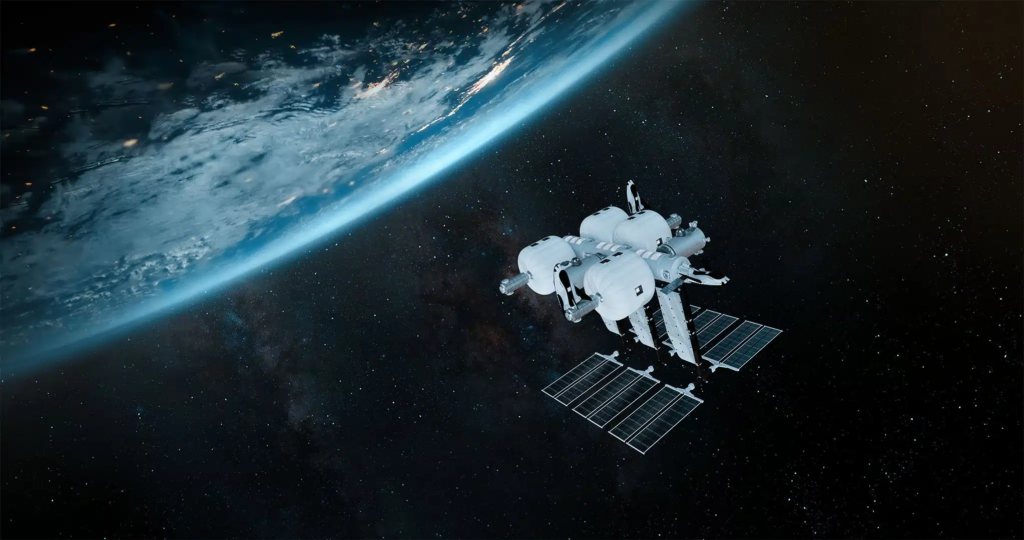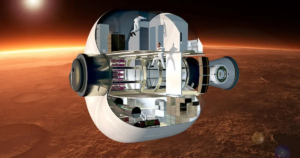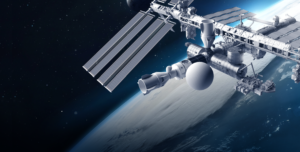
A Closer Look At The End of Orbital Reef
New information suggests that the Orbital Reef space station led by Sierra Space and Blue Origin has run into some significant issues. Specifically, the relationship between the two companies is reported to have gone sour prompting future concerns. This in combination with Blue Origin Orbital Reef employees being moved to different projects along with other leadership changes, and the station’s outlook is not looking good.
For years now, the two companies funded by NASA have been working to develop their respective parts of the station. For Blue Origin this includes New Glenn, the primary station modules, and a few other contributions. Sierra Space has been working on Dream Chaser, and the inflatable LIFE Habitat. The plan was to come together later this decade and create a unique environment in low Earth orbit.
A project NASA was supporting as the agency needs options in LEO after the space station retires. Unfortunately from them, it looks like the options are slowly going away. Here I will go more in-depth into the company’s relationship, the future of Orbital Reef, NASA’s concerns, and more.
Ending Partnership

Starting in October 2021, plans were announced for the Oribtal Reef station. They describe the station as the premier mixed-use space station in low Earth orbit for commerce, research, and tourism by the end of this decade. Between the announcement and last year, they completed a few design reviews and various project milestones. Progress had seemed to slow somewhat recently but at the time that was practically all that we had heard.
While there have been no official statements from either Blue Origin or Sierra Space, behind the scenes some big changes are happening. CNBC first reported that according to three people, Blue Origin and Sierra Space are now in the process of navigating a potential end to the Orbital Reef partnership. They were quoted saying, “Those people, speaking on the condition of anonymity to discuss nonpublic matters, emphasized that discussions are ongoing and described the situation as fluid. But other development projects with more significant current contracts – such as Blue Origin’s Blue Moon lunar lander and Sierra Space’s Dream Chaser spaceplane – have taken higher priority for both companies, those people said.
In addition to these comments, we have seen a few changes within Blue Origin that also suggest this future. For example, earlier this year, the company reassigned quite a few of its employees working on Orbital Reef. The staff that was working on the station was moved to other programs such as Blue Origin’s new moon lander contract with NASA, the sources said. Even Brent Sherwood, the head of Blue Origin’s Advanced Development Programs that oversees Orbital Reef, plans to leave the company by the end of the year.
This joins a long list of other Blue Origin leadership changes within the past few months. Just recently, Bezos told Blue Origin employees that longtime Amazon executive Dave Limp would replace Blue Origin’s current CEO by year’s end.
As far as what all this means for the future, the two companies are expected to continue working on their respective station hardware. For the most part, the main contributions both Blue Origin and Sierra Space were working on are projects the two companies need no matter what. Dream Chaser and New Glenn for example are going to be built and utilized no matter the state of Orbial Reef. The LIFE module and main station modules on the other hand are somewhat unique. Sierra Space has made a lot of progress on the LIFE habitat and expects to complete full-scale testing very soon. This technology has a lot of potential and could be used for a station solely developed by Sierra Space. Blue Origin on the other hand seems to be taking quite a few steps back from the station and might not come back to it for a while.
It’s also important to point out that the Orbital Reef project has already been at least partially funded by NASA. At the start, Blue Origin won a $130 million contract from NASA for design work on the private space station. That contract was one of three funded Space Act Agreements (SAA) that NASA issued for the first phase of its Commercial LEO Destinations (CLD) program. NASA spokesperson Rebecca Wickes told CNBC in a statement that the agency has so far paid Blue Origin $24 million of the total contract amount for completing specified milestones. As of yet “there are no current plans to transfer the agreement,” Wickes said. One problem that adds to an even bigger list of issues NASA will now face.
NASA’s Concern

Over the past few years, as NASA prepares to retire the ISS, they strategically funded four main companies each planning to create their own commercial space station. Specifically, in December 2021, NASA awarded space act agreements to Blue Origin, Nanoracks and Northrop Grumman to develop free-flying space destinations. They also gave a large contract to Axiom Space. In the last month alone, half of these options have dropped out. Besides the Orbital Reef concerns I just went over, new reports highlight that Northrop Grumman is also expected to give up.
Their plan was to leverage its successful Cygnus spacecraft design to build a free-flying space station. However, Eric Berger reported that they no longer plan to do that. Instead, it will join the venture backed by Voyager Space, which is partnering with Europe-based Airbus to develop a commercial space station. It’s likely that Northrop would provide cargo transportation services, with Cygnus as part of the team. Officials from Voyager and Northrop Grumman declined to comment on the change in strategy, which could be announced soon” he said.
These new developments have got to be quite concerning for NASA as the agency wanted multiple options to ensure something was available by 2030. The agency was quoted saying, “NASA is working closely with commercial companies to develop new space stations capable of providing services to NASA and others, which will ensure that the U.S. maintains a continuous human presence in low Earth orbit and provides direct benefits for people on Earth. Leading into NASA’s future procurement for commercial low Earth orbit services, the agency will provide industry with draft requirements and standards for review by the end of 2023.”
The agency’s plan was to enable a vibrant commercial marketplace in low Earth orbit by incubating private astronaut missions and helping to advance other commercial space-related efforts. The agency recently committed to partnering with seven U.S. companies on a variety of commercial space projects, including additional space station destinations and transportation collaborations. On the private astronaut front, the second private astronaut mission to the International Space Station successfully completed in May 2023, with work underway to prepare for the third private astronaut mission.
In another quote, they point out, “NASA’s commercial strategy for low Earth orbit will provide the government with reliable and safe services at a lower cost and enable the agency to focus on Artemis missions to the Moon in preparation for Mars, while also continuing to use low Earth orbit as a training and proving ground for those deep space missions.” Recently developments have made this statement not age very well.
While not ideal, thankfully for NASA, Axiom Space seems to have always been the main option and most reliable. By now, the company is not far away from completing its first module which will then go through testing. Unlike the other stations, Axiom has the unique opportunity to connect with the ISS and then detach before it retires. This partnership and strategic connection is hoping to allow Axiom Space to effectively adopt and service the multinational user base of the ISS National Laboratory to seamlessly continue research and manufacturing initiatives. The plan is for Axiom Station to host people, research and manufacturing that will lead development for numerous industries using techniques that are available only in microgravity. They believe the station will also service the rapidly expanding infrastructure and solutions operating in space and provide an accessible platform for private companies and national governments to continue the research and development of breakthrough innovations.
Last year, the chief government and external relations officer at Axiom Space, said the company now plans to launch its first commercial module to be installed on the ISS in 2025. The company just “rebaselined” that schedule as it goes through a critical design review of the module. A second module, a clone of the first, would follow in six to eight months” she said. In the time since this comment, Axiom has made a lot of progress. A recent video update provided by the company showcases the Hab One structure and main components within the manufacturing facility. This is a good sign and we should continue to receive more updates in the future. As for the other companies, the risk of building a commercial space station among other reasons is what likely caused them to move on. Instead, they have decided to focus on other projects like New Glenn and a lunar lander.
Conclusion
After years of gradual progress on Orbital Reef, it looks like the station is coming to an end as Blue Origin moves on to different developments. The relationship between Blue Origin and Sierra Space has degraded and only contributed to the current situation. We will have to wait and see how it progresses and the impact it has on the space industry.



